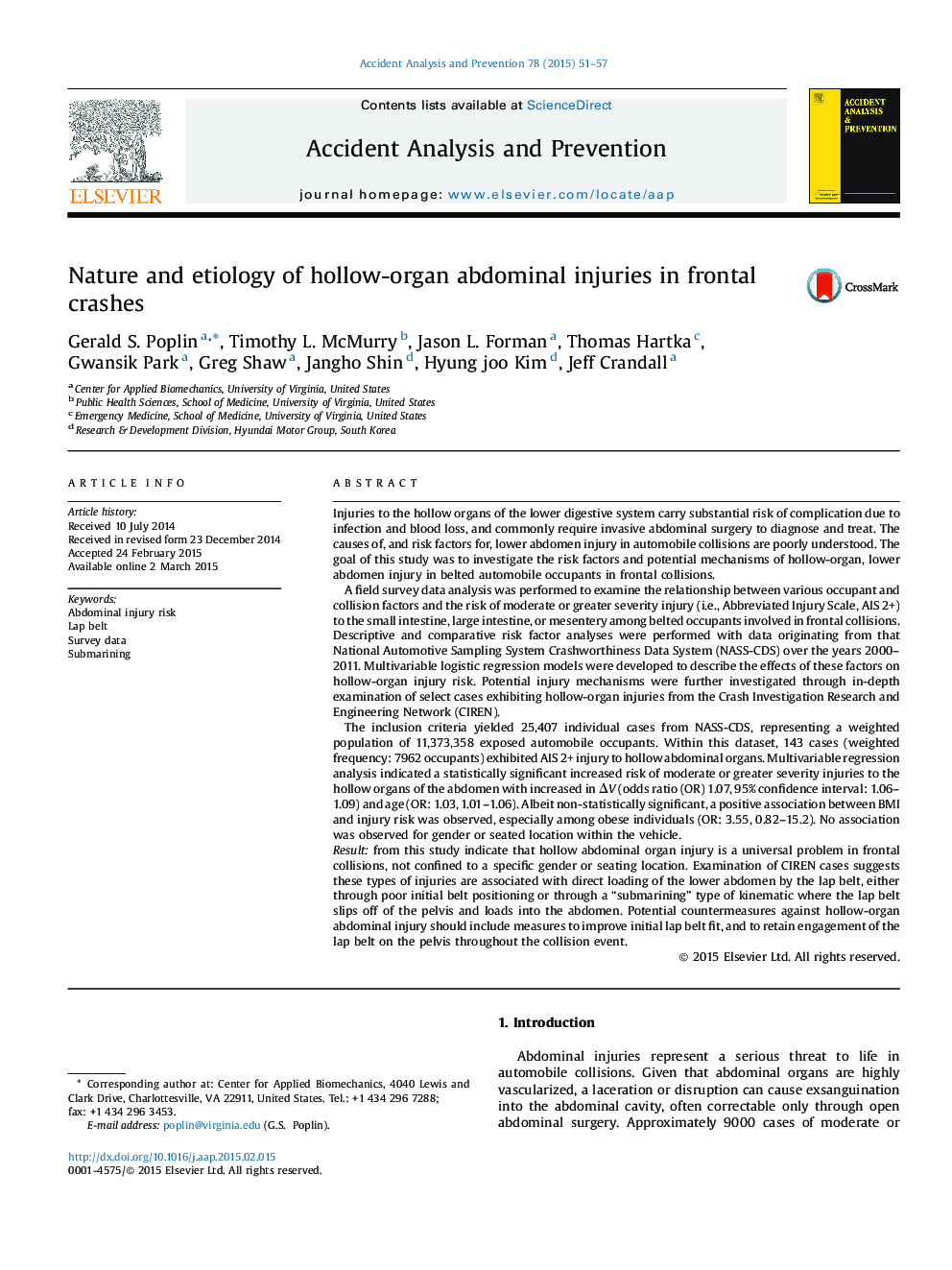| کد مقاله | کد نشریه | سال انتشار | مقاله انگلیسی | نسخه تمام متن |
|---|---|---|---|---|
| 572227 | 1452919 | 2015 | 7 صفحه PDF | دانلود رایگان |
• Injuries to the hollow-organs of the abdomen have significant clinic ramifications, yet the mechanisms of their occurrence in MVCs are poorly understood.
• The change in velocity (ΔV) and age are strong contributors to the risk of lower abdominal, hollow-organ injuries.
• Increased waist circumference, as indicated by increased BMI, suggests less potential for proper engagement with the lap belt and increased likelihood for submarining kinematics and injury.
Injuries to the hollow organs of the lower digestive system carry substantial risk of complication due to infection and blood loss, and commonly require invasive abdominal surgery to diagnose and treat. The causes of, and risk factors for, lower abdomen injury in automobile collisions are poorly understood. The goal of this study was to investigate the risk factors and potential mechanisms of hollow-organ, lower abdomen injury in belted automobile occupants in frontal collisions.A field survey data analysis was performed to examine the relationship between various occupant and collision factors and the risk of moderate or greater severity injury (i.e., Abbreviated Injury Scale, AIS 2+) to the small intestine, large intestine, or mesentery among belted occupants involved in frontal collisions. Descriptive and comparative risk factor analyses were performed with data originating from that National Automotive Sampling System Crashworthiness Data System (NASS-CDS) over the years 2000–2011. Multivariable logistic regression models were developed to describe the effects of these factors on hollow-organ injury risk. Potential injury mechanisms were further investigated through in-depth examination of select cases exhibiting hollow-organ injuries from the Crash Investigation Research and Engineering Network (CIREN).The inclusion criteria yielded 25,407 individual cases from NASS-CDS, representing a weighted population of 11,373,358 exposed automobile occupants. Within this dataset, 143 cases (weighted frequency: 7962 occupants) exhibited AIS 2+ injury to hollow abdominal organs. Multivariable regression analysis indicated a statistically significant increased risk of moderate or greater severity injuries to the hollow organs of the abdomen with increased in ΔV (odds ratio (OR) 1.07, 95% confidence interval: 1.06–1.09) and age (OR: 1.03, 1.01–1.06). Albeit non-statistically significant, a positive association between BMI and injury risk was observed, especially among obese individuals (OR: 3.55, 0.82–15.2). No association was observed for gender or seated location within the vehicle.Resultfrom this study indicate that hollow abdominal organ injury is a universal problem in frontal collisions, not confined to a specific gender or seating location. Examination of CIREN cases suggests these types of injuries are associated with direct loading of the lower abdomen by the lap belt, either through poor initial belt positioning or through a “submarining” type of kinematic where the lap belt slips off of the pelvis and loads into the abdomen. Potential countermeasures against hollow-organ abdominal injury should include measures to improve initial lap belt fit, and to retain engagement of the lap belt on the pelvis throughout the collision event.
Journal: Accident Analysis & Prevention - Volume 78, May 2015, Pages 51–57
